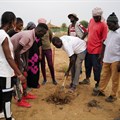Africa's Great Green Wall, which is meant to restore degraded landscapes and boost economies across the continent, is low on cash and unlikely to meet a 2030 completion goal, the president of the most recent UN summit on desertification told Reuters.

A girl carries a jerrycan filled with water at a Tolou Keur garden in the Walalde department of Podor, in the Great Green Wall of the Sahara and the Sahel area, Senegal, 11 July 2021. Reuters/Zohra Bensemra/File Photo
Launched in 2007, the project to reinstate 100 million hectares of land is only 30% complete, said Alain Richard Donwahi, president of the 2022 UN summit held in the Ivory Coast, who has access to the analysis of how it is progressing.
The project aims to restore an 8,000km-long (5,000 mile-long) corridor from the Atlantic to the Red Sea and benefits some of the world's poorest countries at the edge of the Sahara Desert, including Ethiopia, Mali and Sudan.
More support necessary
"It is an understatement to stress that we are not in line with our common objective to complete by 2030," Donwahi said ahead of the World Day to Combat Desertification and Drought in Bonn on 17 June, where he will seek renewed support for the landmark project.
"The project faces substantial challenges, primarily in terms of financing and implementation," said Donwahi, who serves as president of the UN summit on desertification until the next one in Riyadh, Saudi Arabia, in December.
With no centralised monitoring strategy, coordinating the work across the 11 African countries involved has been especially challenging, Donwahi said.
Meanwhile, some of those countries have been beset by humanitarian crises in recent years fuelled by military coups, war, or Islamist insurgencies.
The project was estimated to need at least $33bn more funding to achieve its 2030 target, according to a progress review in 2020 by the UN Convention to Combat Desertification (UNCCD), which has provided occasional implementation reports.
Christophe Van Der Perre and Cooper Inveen 29 Jul 2021
International donors pledged some $19bn at a 2021 summit, but by March of last year, only $2.5bn had come through, with the rest due by end-2025, according to the most recent funding update from the UNCCD.
Those pledged funds are also being spread across different projects that may be dedicated to international development, but not necessarily to the Great Green Wall, Donwahi said.

An aerial view shows participants of a Tolou Keur programme working on a newly built Tolou Keur garden in Boki Diawe, within the Great Green Wall area, in Matam region, Senegal, 10 July 2021. Picture taken with a drone. Reuters/Zohra Bensemra/File Photo
Finance monitor
The difficulty keeping track of funding so far has been a key stumbling block, he added, welcoming the launch in June of an 'observatory' to monitor financing and progress.
Even so, it is unclear where the project will get the remaining billions needed to get back on track. Donwahi said more investment would be needed from international donors, the private sector and Green Wall countries themselves.
Donwahi noted some progress, including 3 million jobs created in the restoration of the some 30 million hectares (74 million acres) of degraded land, roughly equivalent to the size of the Philippines.
With climate change escalating, though, the issue was increasingly a problem the wider world needs to face, said Donwahi, adding: "For too long, desertification and drought have been considered African problems".




































